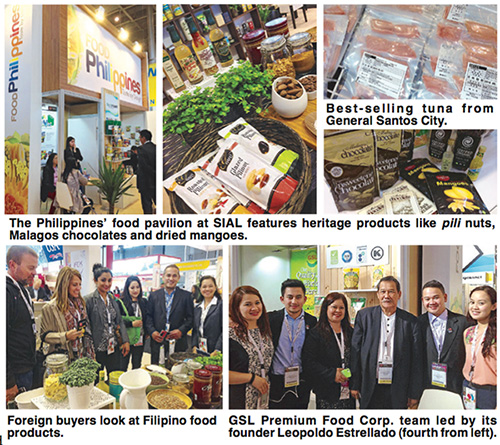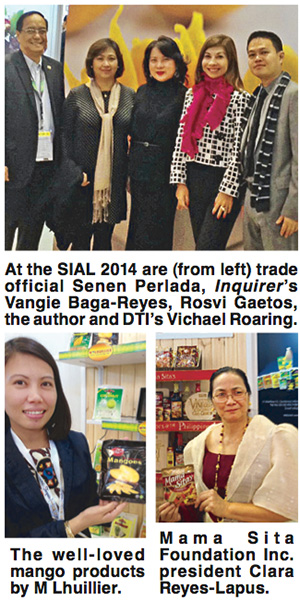Pinoy food gets the spe-SIAL treatment in Paris

PARIS — A top-level, high-powered Philippine contingent is pushing for “terroir-rism” to put Pinoy food products in the forefront of the world’s best.
At the recently concluded Salon International de l’Alimentation or SIAL Paris, Europe’s foremost biennial food event that provides food brands the opportunity to connect with more than 5,000 companies and over 130,000 trade buyers from 200 countries, “terroir”-based Philippine tuna, caldereta mixes, banana chips, dried mangoes, fresh tuna and calamansi liqueur competed for the attention of 130,000 trade buyers to land in the shelves of top supermarkets, grocery stores and delicatessens around the world.
“SIAL is the biggest show in the world, with a booming market,” declared Nicolas Trentesaux, SIAL Group director, during an evening cruise he hosted for delegates along the river Seine in the City of Light.

An impressive $24.4 million in sales was harvested by 12 of the 15 participating Philippine exhibitors in the five-day SIAL food expo at the Paris Nord Villepinte, with tuna as the best-seller, according to Rosvi Gaetos, executive director of the Philippines’ Center for International Trade Expositions and Missions (CITEM). Sales were up by $2.2 million from SIAL 2012. Incidentally, this year’s fair marks SIAL’s 50th anniversary.
With a 300-square-meter country pavilion that was light and pleasing to the eye with its clean lines and rainbow colors, the Philippines attracted a number of firm orders and inquiries that born from the joys of “terroir!”
“Taste by place is taste by terroir — it is taste by design,” explains the indefatigable Rosvi Gaetos. “For instance we have Davao pomelo, because it has that certain characteristic only from Davao, Malagos chocolate, Dagupan bangus. Just like only products from the Champagne region of France can be called champagne!”

According to the French Embassy in the US, terroir is a mix between a geographical definition and a cultural one. “It is a geographical area with specific geological, hydrological, soil and climate characteristics. But it is more than that. The terroir has a strong cultural side. It is the reflection of the human societies that work its land. Different societies produce different terroir with the same territory.”
According to Rosvi, Philippine terroir products, also called heritage, reflect the country’s rich, natural climate and fertile tropical land combined with age-old tradition and practices that are essential in producing the unique flavors of each of the products.
It’s “flavor with a purpose,” according to the Department of Trade and Industry, which CITEM is under. “Our product, our taste is well thought of. Not accidental, but by design.”
* * *
Among this year’s exhibitors is Mama Sita’s, which drew crowds because its Mama Sita Foundation Inc. president Clara Reyes-Lapus and chef Vicky Rose Pacheco demonstrated the cooking of tinola, caldereta and adobo with Mama Sita’s Instant Mixes.
Another crowd drawer were the banana chips exhibitors like GSL Premium Food Export Corp., which exports two million pounds a month of banana chips to Europe, according to its founder, Leopoldo Estrellado. He said the demand is even greater than this! He started with only two vats (cawa) of bananas and now he is a leading supplier of banana chips in the world, with bananas grown in Davao. B-G Fruits and Nuts was also very popular.
M Lhuillier is also making a name worldwide for its mango products, especially with those without added sugar.

Also popular were Franklin Baker Company of the Philippines, whose desiccated coconut and sweetened coconut products you taste in Italian chocolates and other pastries. 65 million pounds of desiccated coconut are sold annually by Franklin Baker and its customers include Ferrero Rocher and Kellog’s. There is also JUD Products Philippines Inc., which exports cocoro sugar.
Frozen vacuumed-packed tuna fillets by Philfresh Corp., perhaps the only one selling tuna in the expo, were found in the Philippine Pavilion. Europe is said to be a tuna-eating, not a sardine-eating, continent.
The Philippines’ own PTTC was exhibiting Destileria Limtuaco’s Calamansi Liqueur, which was later mixed into a calamansi Margarita by Pinay barista Dimples Reytas.
Virtually all exhibitors in the Philippine pavilion are HACCP-, Halal- and Kosher-certified.
CITEM deputy executive director Rhea Matute further points out, “Nowadays, there is a lot of interest in the history of the ingredient. Why it’s from the Philippines. What’s indigenous to the Philippines, what grows best in its climate and soil. The food feels authentic.”
According to Rhea, there is a strong association between the Philippines and mangoes (the best!), coconut products, pili nuts, bananas, calamansi from Mindoro and single-origin chocolates like the Malagos chocolate of Davao.
“Somehow it’s the local cuisine that attracts the buyers,” adds Rhea.
According to trade official Senen Perlada, food exports are second only to electronics in terms of export income, raking in $7 billion a year for the economy. This is why the government is going all out to support food exporters, especially small and medium enterprises (SMEs).
“Because ultimately, we are helping boost the supply chain. The sales of these SMEs redound to the good of companies that employ thousands of farm workers,” stresses Rosvi.
And that, dear countrymen, is nation-building by design, too. Photos by Joanne Rae Ramirez (You may e-mail me at [email protected].)
- Latest
























